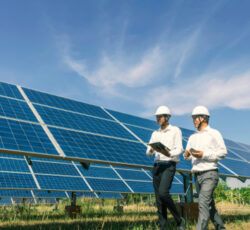 In recent years, solar power has become increasingly popular among businesses seeking renewable energy solutions. Installing solar panels on your commercial property not only reduces your environmental impact but also offers long-term financial benefits. If you’re considering adding solar to your commercial business, here are the steps you need to follow:
In recent years, solar power has become increasingly popular among businesses seeking renewable energy solutions. Installing solar panels on your commercial property not only reduces your environmental impact but also offers long-term financial benefits. If you’re considering adding solar to your commercial business, here are the steps you need to follow:
1. Evaluate Your Energy Needs
Before diving into the solar installation process, it’s crucial to evaluate your energy needs. Assess your current energy usage, determine how much electricity you want to produce with solar, and identify any specific energy goals you have for your business. This evaluation will help you understand the size and capacity of the solar system you need to meet your energy requirements.
2. Conduct a Solar Feasibility Study
Next, you’ll need to conduct a solar feasibility study to determine if your commercial property is suitable for solar installation. This study will evaluate factors such as the availability of sunlight, roof condition, shading, and the structural integrity of your building. A professional solar installer can conduct this study and provide you with a comprehensive assessment of the viability and potential output of a solar system for your business.
3. Choose a Solar Installer
Selecting the right solar installer is crucial to the success of your solar project. Look for experienced and reputable solar installers who specialize in commercial solar installations. Research their track record, read customer reviews, and get multiple quotes to compare pricing and services. Make sure that the chosen installer has the necessary licenses, certifications, and insurance to work on your commercial property.
4. Designing the Solar System
Once you’ve chosen a solar installer, they will work with you to design a customized solar system that meets your energy needs and integrates seamlessly with your commercial building. The design process will consider factors such as the available roof space, the tilt and orientation of the panels, and any shading issues. The installer will also guide you in choosing the right solar panels, inverters, and other necessary equipment for your project.
5. Obtain Permits and Approvals
Before any construction or installation work can begin, you will need to obtain the necessary permits and approvals from local authorities. This process may involve submitting plans and applications, paying fees, and adhering to specific regulations and building codes. Your solar installer should be familiar with the local requirements and assist you in securing the permits needed for installing the solar system on your commercial property.
6. Financing Options and Incentives
Consider the available financing options and incentives to make your solar project more financially feasible. Explore options such as cash purchase, solar loans, lease agreements, or power purchase agreements (PPAs). Additionally, research any government or utility incentives, tax credits, or grants that can help offset the installation costs. These financial incentives can significantly improve the return on investment for your commercial solar project.
7. Construction and Installation
With all the preliminary work complete, it’s time to move forward with the construction and installation phase. Your solar installer will coordinate with you to schedule the installation, ensuring minimal disruption to your business operations. The installation process involves mounting the solar panels on your commercial property’s roof or ground, connecting the panels with the inverter, and integrating the system with your electrical infrastructure.
8. Testing and Commissioning
After the installation, the system will undergo testing and commissioning to ensure it is operating efficiently and safely. The solar installer will conduct performance checks, inspect the electrical connections, confirm the system is connected to the grid (if applicable), and provide you with documentation and warranties once everything is satisfactory.
9. Monitoring and Maintenance
Once your commercial solar system is up and running, it’s important to monitor its performance regularly. Most solar installations come with monitoring systems that allow you to track energy production and the system’s overall performance. Additionally, schedule regular maintenance inspections with your solar installer to identify and address any potential issues promptly.
Conclusion
Adding solar to your commercial business can have a significant positive impact on your energy costs and sustainability efforts. By carefully evaluating your energy needs, conducting a feasibility study, choosing the right solar installer, designing the system, obtaining permits, exploring financing options and incentives, installing the system, testing and commissioning, and implementing ongoing monitoring and maintenance, you can successfully integrate solar power into your commercial property and reap the long-term benefits.
